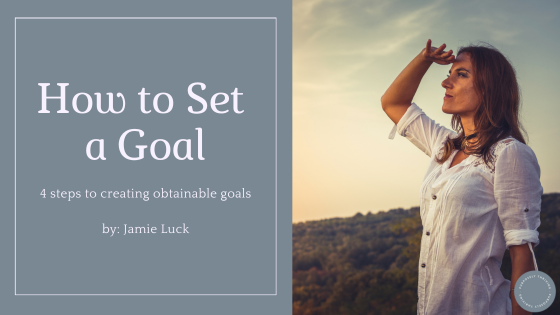By Jamie Luck, M.Ed., B.B.A., CPT
#Goals.
Haven’t we all seen this hashtag that is taking over social media captioning? It’s a word, and now buzzword, that we can all relate to, because all goals stem from our desires. It conjures up feelings of expectation and satisfaction as we ponder the realization of the prize we want and stirs up in us an ambition to achieve it. When I think about “goals,” I feel excited- they are great, right?! “I will feel so good when I arrive.” However, that excitement starts to turn into intimidation when I begin to think about the distance I have to go to get there, and begs the question in my mind “Can I do it?”
For many of us, the word “goal” is both invigorating and overwhelming. While our desire is very much in the present, the goal can have a far-off feeling to it and the path to achievement is not necessarily clear, especially when it comes to our health and fitness. “I want to be healthy.” “I want to lose ten pounds.” “I want to get stronger.” We know what we desire, but how do we get there?
I have found a few keys that have revolutionized the way I view my goals and helped me overcome the feelings of intimidation that can handicap me from starting something new. These keys include mindset, vision, baby steps, and forward thinking. As I changed my approach, I found that goals I saw as “pie in the sky” became realities! I believe these keys make goal setting and goal ACHIEVING something everyone can do.
Mindset
James Clear writes in his book Atomic Habits “Behind every system of actions is a system of beliefs.” Everything we do, both consciously and subconsciously, comes from the mindsets we hold about ourselves and the world around us. This may sound surprising, but the goal is not really the goal. The REAL aim is becoming the fullest version of myself, the person God made me to be, equipped to do all that He created me to do, and experience! This is why the thoughts that we think, especially about ourselves, are so important. “As a man thinketh in his heart, so is he.” (Proverbs 23:7). Neuroscience has proven that the thoughts that we think, including the thoughts we think about ourselves, become the hardwiring in our brains! The Bible’s exhortation to “dwell on what is true, and pure and lovely” is not a nice suggestion, it is a prescription for mental health. For years, I lived in a constant state of fear. After a series of several painful events, I found myself constantly waiting for the next shoe to drop. Without even realizing it, I had wired my brain to see everything through a lens of dread. I expected the worst, because that seemed not only the safest way to not be caught off guard, but after all, nothing good ever happened so why should I be hopeful?
I remember the day a friend of mine was quoting a verse from Job, where Job says, “that which I feared has come upon me.” My friend was explaining that fear will come knocking at our door, but we are the ones who decide whether to invite it into our house! He explained that while fearful thoughts will come, we have the power to reject them and replace them with thoughts of truth, and hope. This was revolutionary for me. I had always seen myself as a paralyzed victim standing on the shore while a tidal wave of fear came over me against my will. I decided to begin to fight back, and consciously replace my negative, fearful thinking with thoughts that I KNEW to be true: about myself, God, and the world around me. This process of changing my thinking illuminated how much negativity I was harboring in my mind about myself, and it was shaping my life. I began to let go of the identity I had given myself that I am “just naturally” a worrier, and an anxious person, and someone who can’t get it together. What freedom I began to feel! I liberated myself from the bondage I had created by allowing so much fear and negativity to control my thinking. I always knew my life had purpose, but now I freed myself to live for it unhindered.
Vision
Once I have established a positive, hopeful mindset, I now begin creating a vision for my life- where I want to go and what I want to do. It lifts me up to a higher plane where I see that my life is meant to be a blessing to this world. And so is yours! When creating a vision, great questions to ask yourself are: What makes me excited? What am I doing when I feel the most alive? When have I helped others and felt a deep satisfaction? Sports psychologists have marveled at the power of vision in sports performance. Studies have been done comparing the performances of athletes who practiced for hours honing a skill- shooting a free throw, making a putt, hitting the baseball- with those who spent a fraction of the time practicing the skill, but spent the remaining amount of time envisioning themselves making the free throw, or nailing the putt, or hitting the homerun. The results are astounding: those that spent more time envisioning themselves succeeding and less time practicing performed better than their peers who simply practiced the skill! Having vision for your life in your mind’s eye is crucial.
As we create visions for ourselves, these visions give energy to the goals we set. Why? Because these goals are steppingstones into the lives we were meant to live and becoming the people we were created to be.
Baby Steps: Small and Doable
Placing my goal inside the framework of my identity and life vision, it then becomes something that I can do because it is part of my journey- I already know it is for me. However, the next step I then take is critical: I must break my goal down into small, doable steps so that I don’t overwhelm myself. Any goal set involves some form of change, and the best way to approach change is slow and steady. Most goals we set are long-term; however, a long-term goal should be viewed in short-term increments. It is very tempting when setting a goal and mapping a plan to overextend oneself and attempt to plan too far into the future. A few years ago, I made a goal to read twelve books by the end of the year. Thankfully, I started off in the right mindset- I told myself “You are a reader” (not “you are trying to be a reader”, there is a big difference) and you want to read more to grow as a well-rounded person. However, I thought that telling myself to “read one book a month” was a great plan of action to reach my goal. Well four months into the year, and only one book completed, I realized that my monthly approach was not working. I started each month thinking that I would somehow (magically, I guess!) have read a book by the end of it, with no specifics to my method. After reassessing, I decided to pick three days at the beginning of each week where I would read for 20 minutes each day. Even if this did not add up to twelve books by the end of the year, I knew it would get me reading consistently and set a pattern of reading that I wanted to continue not just through the year, but for the rest of my life.
If your goal is to “get stronger,” try to resist telling yourself you will be at the gym three days a week for the next 4 four months. While that sounds great, and you may even be able to do it, it is likely that something will come up that throws you off your plan. Instead, look at your weeks one week at a time, pick two days that you know you can commit to, designate a set amount of time for being at the gym, and know in advance what you want to do when you get there. Do you like Pilates and cycling but hate weight training? No problem, match your gym days with the class schedule when Pilates and spinning are offered!
When we break down a goal, a goal is made up of habits, and habits are made up of small, doable actions repeated consistently. These small actions need to be very specific and unique to one goal. Using the goal of getting stronger, once I have set my two days at the gym for the current week only, I break it down further to identify exactly what I am going to do to make that happen. I will pack my gym bag the night before, putting a reminder on my calendar to do so. Specificity will help make the steps toward your goal simple and doable! It will also help you stay focused on only one goal at a time, which is the surest way to achieve it. Too much at once overloads our brains, which were never meant to multitask.
Returning back to mindset, as I take each step, I keep the goal “inside” of me: it is not something external that I am reaching for, it is part of the person that I am. Every time I leave the gym, I am aligning with my identity that I am here for a purpose; I am growing into all that God made me to be.
Forward Thinking
The final key is to keep looking forward. Every day is a new day, a fresh start. If I missed the gym entirely last week, it is in the past. This week is a new beginning. In her book Switch on Your Brain, neuroscientist Dr. Caroline Leaf writes the most encouraging news: “Every morning when you wake up, new baby nerve cells have been born while you were sleeping that are there at your disposal to be used at tearing down toxic thoughts and rebuilding healthy thoughts.” It is so true: God has created new mercies for us EVERY morning! Whatever the goal, I can begin again today, and THAT is success.
“…But one thing I do: Forgetting what is behind and straining toward what is ahead, I press on toward the goal to win the prize for which God has called me heavenward in Christ Jesus.” Philippians 3:13-14
Blessings,
Jamie
Jamie is passionate about sharing her knowledge of fitness, nutrition, and total body wellness with others. She has been personal training clients of all ages and abilities for fourteen years. She loves helping people grow their physical, mental and spiritual health so they can be all that God designed for them to be. If you would like to connect with Jamie, you can reach her at ptwithjamie@gmail.com
No content on this site, regardless of date, should ever be used as a substitute for direct medical advice from your doctor or other qualified clinician.




Loved this and the “alive” scriptures you used, especially “what I feared came upon me.” Such a wonderful truth to help me realize how serious fear can be! And the quote “behind every system of action is a system of belief”. I am seeing more it is what I believe about myself that is the driving force behind my actions. Really inspiring and encouraging article for me to get back into the game – a set some achievable goals.
Cathy, I’m so glad this was helpful to you! God is with you and FOR you in the process, which is the best news of all!
Many blessings.